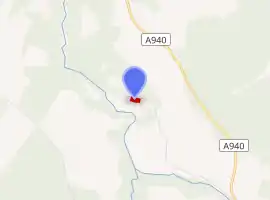Dunphail House
Dunphail House is an Italianate country house in Moray, Scotland. It was designed by William Henry Playfair for Charles Lennox Cumming-Bruce, and was completed in 1829. Originally designated a Category B listed building in 1971, it was upgraded to Category A in 1987, and remains a privately owned residence.
| Dunphail House | |
|---|---|

| |
| General information | |
| Architectural style | Italianate |
| Town or city | Edinkillie, near Forres |
| Country | Scotland |
| Construction started | 1828 |
| Completed | 1829 |
| Design and construction | |
| Architect | William Henry Playfair |
| Designations | Category A listed building[1] |
History
Dunphail House was built between 1828 and 1829 according to a design by William Henry Playfair, the architect responsible for many of the neoclassical buildings in Edinburgh's New Town.[1] It was built near the site of the now-ruined Dunphail Castle[2] for Charles Lennox Cumming-Bruce,[3] a Scottish Conservative politician.
Plans for a new house on the site had already been drawn up by John Baxter in 1787, and by John Patterson from 1817-1820,[4][3] but it was Playfair's plans, which were his first commission for a country house, that were eventually executed.[3] The same year construction was completed, the nearby River Divie flooded and threatened to destroy the house, with the river bank reportedly collapsing to within a yard of the foundations.[2]
Substantial additions were made to the house in 1871 by Alexander Ross.[3][4] Electric lighting was first installed in 1883,[5] drawing power from a dynamo turned by water from the River Divie.[6] The interior plasterwork was extensively remodelled between 1928 and 1932 under the direction of John Wittet CBE,[7] president of the Inverness Architectural Association and Lord Provost of Elgin.[8] Renovation work by Ronald Phillips and Partners, sensitive to the original design, removed substantial parts of Ross's addition in 1964.[3][4]
The house was designated a category B listed building in 1971; it was upgraded to category A in 1987.[1]
Description
The building is of a rectangular Italianate design,[3] mostly of two storeys but with a three-storey tower at the west gable with a pyramidal roof.[1] The original design featured a porte-cochère frontage, which Ross removed and reattached to his own additions in 1871; the 1960s renovation work replaced Ross's frontage with the current porch, which reuses Playfair's original parapet, and features a pair of Roman Doric columns and a Neo-Georgian fanlight.[3] It is constructed of pinned rubble, with polished and tooled ashlar sandstone detailing.[7]
Aside from Wittet's plasterwork, the interior mostly dates from the 1960s renovations,[1] with little of Playfair's original work remaining other than the shape and layout of the rooms.[3]
The house remains a privately owned residence.[9]
References
- Historic Environment Scotland. "Dunphail House (LB2171)". Retrieved 16 April 2019.
- "Dunphail House". Gazetteer for Scotland. Gazetteer for Scotland. Retrieved 22 March 2019.
- Walker and Woodworth (2015). The Buildings of Scotland – Aberdeenshire North and Moray. Newhaven and London: Yale University Press. pp. 555–558. ISBN 9780300204285.
- "DSA Building/Design Report - Dunphail House". Dictionary of Scottish Architects. Dictionary of Scottish Architects. Retrieved 22 March 2019.
- "Dunphail House". The Electrical Review. 13: 346. 1883. Retrieved 22 March 2019.
- "Dunphail House". The Electrician. 11: 579. 1883. Retrieved 22 March 2019.
- "Moray SMR - NJ04NW0074 - Dunphail House - Site Details". Aberdeenshire Council. Aberdeenshire Council. Retrieved 23 March 2019.
- "DSA Architect Biography Report - John Wittet". Dictionary of Scottish Architects. Dictionary of Scottish Architects. Retrieved 23 March 2019.
- "Moray SMR - NJ04NW0074 - Dunphail House - Spatial Information". Aberdeenshire Council. Aberdeenshire Council. Retrieved 23 March 2019.